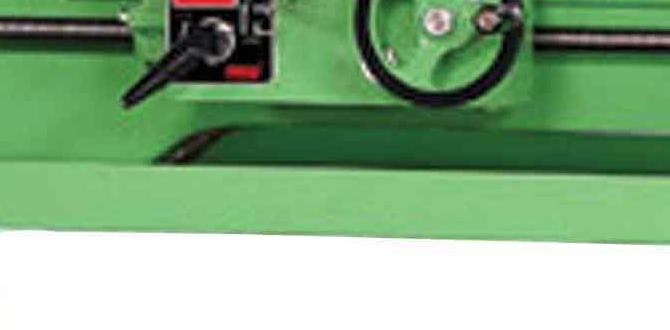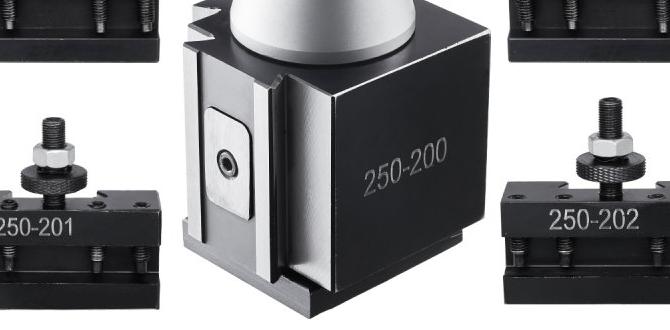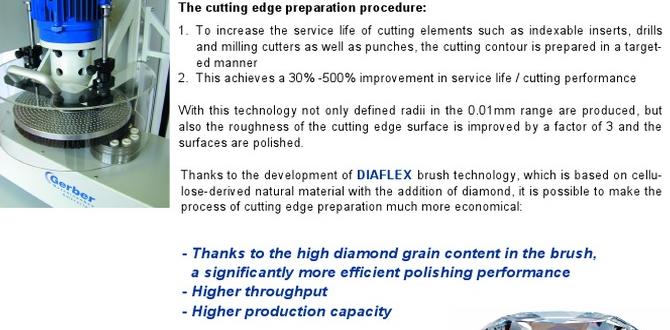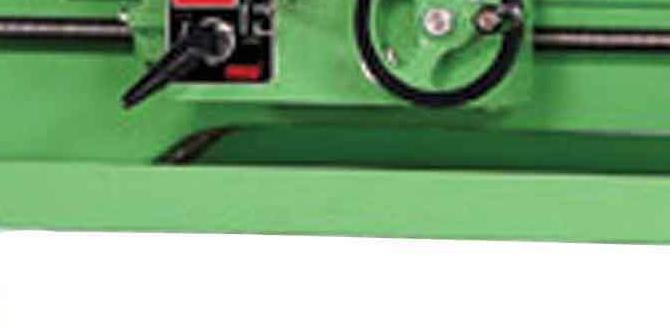Quick Summary
This guide will help you understand and properly use a 1/8-inch carbide end mill with a 6mm shank, focusing on its long-reach capabilities and heat resistance, especially for woodworking applications. We’ll cover its benefits, how to use it safely and effectively, and maintenance tips to ensure great results.
Mastering Your 1/8-Inch Carbide End Mill: A Beginner’s Guide
Ever feel like small, precise cuts are just out of reach? Or maybe you’ve struggled with tools that can’t quite handle the heat when you’re deep into a project? You’re not alone. Many beginners find themselves needing specialized tools for detailed work, but the options can seem a bit overwhelming. Sometimes, a small tool can make a huge difference in the quality and complexity of your projects. That’s where a well-chosen end mill comes in handy. This guide is designed to demystify the 1/8-inch carbide end mill with a 6mm shank, especially those built for longer reaches and heat resistance. We’ll break down exactly what makes this tool special and how you can use it confidently to elevate your woodworking and machining skills. Get ready to unlock new levels of precision!
What is a 1/8-Inch Carbide End Mill?
Let’s start with the basics. An end mill is a type of milling cutter. Think of it like a spinning drill bit, but with cutting edges on the side as well as the tip. This allows it to cut sideways, plunge straight down, and create complex shapes. The “carbide” part refers to the material it’s made from – tungsten carbide. This is a super-hard, durable material that stays sharp much longer than traditional high-speed steel (HSS) and can handle higher temperatures, making it ideal for tougher materials and faster cutting.
The “1/8-inch” specification tells us the diameter of the cutting end. This is a very small diameter, perfect for intricate details, fine خطوط, and small pockets. It’s like having a precision pencil for your CNC machine or milling setup.
The “6mm shank” is the part of the end mill that you grip in your tool holder or collet. A 6mm shank is a common size, particularly in European or metric-based machinery. It’s important that your tool holder can securely grip this size to prevent slippage and ensure accuracy.
Why “Long Reach” and “Heat Resistant” Matter
The “long reach” aspect of this end mill means it has a longer flute (the cutting part) and a longer shank relative to its diameter. This is crucial for reaching into deep recesses or cutting areas that are far from the edge of your workpiece. Imagine carving a detailed design into the inside of a box or creating deep channels without needing a much larger, potentially less agile tool. The long reach allows for greater access and flexibility in your designs.
The “heat resistant” quality, often inherent in good carbide, is vital. When cutting, especially at higher speeds or in denser materials, friction creates heat. Cheap or unsuitable end mills can overheat, lose their sharpness quickly, become brittle, or even break. Good carbide construction, often combined with specific coatings, is designed to dissipate heat effectively, maintaining its cutting edge and structural integrity. This means more consistent cuts, longer tool life, and safer operation.
Ideal Uses for This Specific End Mill
Given its size, material, and design, a 1/8-inch carbide end mill with a 6mm shank, long reach, and heat resistance is particularly suited for several tasks:
- Detailed Engraving: For adding text, logos, or intricate patterns to wood or soft plastics.
- V-Carving: Creating sharp, defined V-shaped grooves for decorative effects or sign-making.
- Small Pocketing: Machining out small, precise areas, perhaps for inlays or electronic components.
- Chamfering and Rounding: Creating small, crisp bevels or rounded edges on delicate pieces.
- 3D Carving Small Features: Machining fine details in relief carvings or miniatures.
- Prototyping: Quickly creating small prototype parts or test cuts in the workshop.
While primarily discussed here for woodworking, these end mills are also valuable for light machining of plastics and non-ferrous metals like aluminum, provided the machine and setup are appropriate.
Choosing the Right End Mill: Key Features
When you’re looking for this type of end mill, keep these specific features in mind:
- Number of Flutes: For wood, 1 or 2 flute end mills are generally preferred. More flutes can clog more easily with wood dust. Carbides with fewer flutes excel at chip evacuation, which is critical in wood.
- Coating: While not always necessary for wood, coatings like TiN (Titanium Nitride) or AlTiN (Aluminum Titanium Nitride) can further increase hardness, reduce friction, and improve heat resistance, extending tool life.
- Helix Angle: A higher helix angle (e.g., 30-45 degrees) is often better for wood as it provides a shearing action that clears chips effectively and reduces tear-out. A standard 30-degree helix is a good all-rounder.
- End Cut Type: Most end mills are “center cutting,” meaning they can plunge directly down into the material. This is essential for many carving and pocketing operations.
Getting Started: Setting Up Your End Mill
Safety and proper setup are paramount, especially with small, high-speed tooling. Here’s how to prepare:
1. Inspect the End Mill
Before you do anything else, take a close look at the end mill. Check for any nicks, chips, or signs of damage on the cutting edges or the shank. Ensure the flutes are clean and free of debris. A damaged end mill won’t cut cleanly and can break, posing a safety hazard.
2. Secure the Tool Holder/Collet
You’ll need a tool holder or a collet that can securely grip a 6mm shank. If you’re using a router or spindle, ensure it accepts the correct collet size. Always use a high-quality collet that is clean and undamaged. A slightly worn or dirty collet can lead to runout (wobble), which degrades cut quality and can cause the end mill to break.
For CNC machines, this involves inserting the end mill into a collet, then into the collet nut, and finally tightening the collet nut in the spindle. For a manual milling machine, you’ll insert the shank directly into a collet chuck and tighten it.
3. Mount the Tool Holder in Your Machine
Insert the collet with the end mill into your machine’s spindle or tool holder. Make sure it’s fully seated. If using a collet chuck, tighten it firmly according to the manufacturer’s instructions. Tighten the collet nut snug, but don’t overtighten, especially on routers, as you can damage the collet or nut.
4. Set the Spindle Speed (RPM)
The correct spindle speed (how fast the end mill spins) is crucial for a clean cut and tool longevity. For a 1/8-inch carbide end mill in wood, speeds can vary, but a good starting point is often between 18,000 and 24,000 RPM. Consult the end mill manufacturer’s recommendations if available. Too slow can lead to burning; too fast can lead to tear-out or put excessive stress on the tool.
For 6mm shank end mills, check the maximum RPM rating of your spindle or router to ensure you don’t exceed it.
5. Set the Feed Rate
The feed rate is how fast you move the end mill through the material. This works in conjunction with the spindle speed. For a 1/8-inch end mill, you’ll typically use a relatively fast feed rate to ensure it “chips” rather than rubs. Aim for a chip load of about 0.002 to 0.005 inches per flute for wood. This often translates to a feed rate of 20-60 inches per minute (IPM) on a CNC, depending on the material density and spindle.
On a manual machine, this is controlled by your hand pressure and the feed screws. You want a consistent, steady feed. Listen to the sound of the cut – a smooth, consistent sound is good; chattering or bogging down indicates an issue.
6. Tool Height (Z-Axis) Setting
Ensure your Z-axis zero point is set correctly on the surface of your material. For plunge cuts, the machine will then move down from this zero point. For most carving and pocketing, the end mill will be cutting into the material from the surface.
Machining Techniques with Your End Mill
Once set up, here’s how to make the most of your 1/8-inch carbide end mill:
Plunging
Because it’s a center-cutting end mill, you can push it straight down into the material. However, for wood, it’s often better to “ramp” into the material. This means the end mill enters the material at an angle (e.g., 5-10 degrees) rather than plunging vertically. Ramping significantly reduces the stress on the end mill and the machine, produces cleaner cuts, and evacuates chips more effectively. Most CAM software (for CNC) has a ramp-entry option.
Pocketing
When machining out an area (a pocket), use an appropriate stepover (the distance the end mill moves sideways between passes). For a 1/8-inch end mill, a stepover of 30-50% of the tool diameter (0.0375 to 0.06 inches) is a good starting point. This ensures efficient material removal and avoids overloading the tool. You can use strategies like pocketing in a spiral or back-and-forth pattern.
Profiling (Cutting Out Shapes)
When cutting a shape out from a larger piece, it’s often best to cut “climb milling” or “conventional milling.” Climb milling (where the cutter rotates in the same direction as the feed) generally provides a cleaner surface finish and reduced tool pressure but can sometimes lead to chatter if the setup isn’t rigid. Conventional milling cuts against the feed direction and can be more prone to tear-out but is sometimes more stable. Experiment to see what works best for your material and machine.
For precise outer profiles, consider making a final “spring pass” – a shallow cut with a very light depth of cut, often at a slightly slower feed rate, using a clean, sharp end mill. This can clean up any slight inaccuracies from previous passes.
Working with the “Long Reach”
When using the long reach of the end mill, remember that longer tools are more prone to vibration and deflection. This means you might need to:
- Reduce your depth of cut: Take shallower passes.
- Reduce your feed rate: Slow down your movement.
- Ensure a rigid setup: Make sure your workpiece is held down securely.
- Use climb milling: It can help reduce chatter.
A longer tool overhang can also lead to increased cutting forces, so ensure your machine’s Z-axis can handle it without excessive deflection.
Working Safely
Safety is non-negotiable in any workshop:
- Eye Protection: Always wear safety glasses or a face shield. Small chips can fly unexpectedly.
- Dust Collection: Wood dust, especially from finer materials, can be a respiratory irritant and a fire hazard. Use a dust collection system.
- Hear Protection: Spindles and routers can be loud. Protect your hearing.
- Machine Guarding: Ensure all guards on your machine are in place and functional.
- Never Leave Running Machine Unattended: Always be present and aware when the machine is operational.
- Secure Workpiece: Make sure your material is clamped down firmly. A spinning workpiece is incredibly dangerous.
- Tool Engagement: Be aware of how the tool is engaging the material. Avoid sudden, jerky movements.
- Understand Your Machine’s Limits: Don’t push your machine beyond its capabilities, especially when using delicate tooling like a 1/8-inch end mill.
Maintenance and Care
To get the most life and best performance from your carbide end mill:
- Clean After Each Use: Remove all wood dust and debris from the flutes and shank. Compressed air or a soft brush works well.
- Avoid Crashing: Never let the spinning tool hit a hard stop, clamp, or fixture. This is the quickest way to break an end mill.
- Store Properly: Keep end mills in a protective case or holder to prevent damage to the cutting edges.
- Monitor Performance: Pay attention to the sound and finish of your cuts. If you start to notice burning, rough surfaces, or increased chatter, it might be time to replace or resharpen the end mill (though resharpening small carbide end mills is often more costly than replacement).
When to Consider a New End Mill
Even with caribt is that it does have a finite lifespan. You’ll know it’s time for a new one if you experience:
- Burning: The wood starts to char, even at the correct speeds and feeds.
- Rough Cuts: The surface finish deteriorates significantly.
- Chatter or Vibration: The tool becomes noisy and unstable.
- Increased Cutting Forces: You have to push harder, or the machine struggles.
- Visible Damage: Chips, dullness, or wear on the cutting edges.
Replacing a worn-out end mill with a fresh, sharp one can dramatically improve your results and is often more cost-effective than trying to push a dull tool.
Comparison: Carbide vs. HSS for Woodworking
While this guide focuses on carbide, it’s worth noting why carbide is often preferred for applications demanding precision and durability, even in wood:
| Feature | Carbide End Mill | High-Speed Steel (HSS) End Mill |
|---|---|---|
| Hardness | Very High | Moderate |
| Heat Resistance | Excellent | Good, but loses temper at lower temperatures than carbide |
| Edge Retention | Excellent, stays sharp longer | Good, but dulls faster, especially in denser materials or at higher speeds/feeds |
| Brittleness | More brittle, can chip if mishandled or subjected to impact | Less brittle, more ductile |
| Cost | Generally Higher | Generally Lower |
| Ideal For | Detailed work, harder woods, plastics, high-production runs, CNC precision. | Softer woods, general-purpose work, occasional use, where cost is a primary factor. |
| Machining Speeds | Can handle higher RPMs and faster feed rates. | Requires lower RPMs and slower feed rates to avoid overheating and dulling. |
For the intricate detail that a 1/8-inch end mill provides, the superior edge retention and heat resistance of carbide are significant advantages, especially when working with CNC machines that operate at high speeds.
Pro Tips for Precision Wood Carving
Here are a few extra tips to help you achieve excellent results:
- Test Cuts: Always make a test cut on a scrap piece of the same material before cutting your final project. This helps you dial in your speeds, feeds, and depth of cut.
- Material Density: Different woods have different densities. Softer woods (like pine) will cut more easily than hardwoods (like oak or maple). You might need to adjust your feed rate and depth of cut accordingly.
- Grain Direction: Be mindful of wood grain. Cutting across the grain can sometimes lead to tear-out, especially with small tools. Consider your cutting direction.
- Featherboards and Hold-downs: Use featherboards to keep the workpiece down and guide the cut, especially on CNC machines. Ensure all clamps and hold-downs are positioned so the end mill won’t hit them.
For more advanced information on machining principles and speeds/feeds, the NASA website offers insights into material machining that can be applied to general workshop practices.
Frequently Asked Questions
What is the best type of end mill for detailed wood carving?
For highly detailed work in wood, especially with CNC routers, a 1/8-inch carbide end mill is an excellent choice. Look for dedicated wood carving bits which often have fewer flutes (1 or






